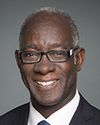I also referenced the disability pension, which is the monthly amount.
If we look right now, from the veterans emergency fund in last fiscal year, just over $1 million was provided in support to 574 veterans and survivors. We also have the veterans independence program, which provides a number of supports and services to veterans. For example, right now it is supporting 28,000 survivors alone. The income replacement benefit is being provided to approximately 400 survivors. We have disability benefits being provided to over 36,000 survivors as well.
That gives you some scope on the number of survivors we are supporting through a variety of mechanisms, both shorter term, such as the veterans emergency fund, and longer term, through disability benefits and the income replacement benefit.




